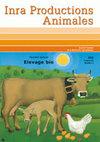Aménagement des logettes et confort des vaches laitières
IF 0.6
4区 农林科学
Q3 Agricultural and Biological Sciences
引用次数: 2
Abstract
Cubicle housing offers a good compromise between the needs of the animals and those of the breeders; it is one of the main housing systems for dairy cows. The recommendations relative to the design and management of cubicle housing are, however, always subject to revision. Special attention is now being given to the improvement of animal comfort, particularly with regards to the lying cow. In this context, the level of comfort is estimated by the duration of the lying time, the frequency of the lying bouts and the ease with which cows are able to get up and lie down. The level of cow comfort is in direct relation to the softness of the floor, to the cubicle dimensions, and to the design of the lateral and frontal partitions. A soft floor can be assured through the use of either multilayer mattresses or a thick litter. Mattresses must be covered with a litter material that absorbs surface moisture and helps to ensure the cleanliness of the stall and udder. To achieve these objectives, the nature of the litter material (straw, sawdust, sand, lime, etc.) appears to be less important than the frequency of renewal. Cubicle floors covered with a thick layer (± 20 cm) of litter seem generally better appreciated by the cows than those equipped with mattresses, and their use is associated with a lower frequency of leg injuries as well as lameness. Sand appears to be a top-grade material for ensuring animal comfort. Nevertheless, the maintenance of a thick layer of litter demands an extra daily labor requirement and the handling of sand as a litter material requires specific equipment. There is a wide range of recommendations on cubicle dimensions due to differences in cow size and the need to take into account the cleanliness of the floor. Lateral partitions must be evaluated for their effectiveness in constraining the animal from spilling out into the neighboring cubicles while at the same time avoiding both injury and difficulties experienced by the cow in getting up and lying down.Finally, frontal partitions must be evaluated regarding their effectiveness in providing sufficient space to allow the cow to thrust its head forward as it stands up.小隔间的布置和奶牛的舒适
小隔间在动物的需求和饲养员的需求之间提供了一个很好的妥协;它是奶牛的主要饲养系统之一。然而,有关隔间住房的设计和管理的建议总是需要修订的。目前正在特别注意改善动物的舒适度,特别是对奶牛的舒适度。在这种情况下,奶牛的舒适程度是通过躺的时间长短、躺的频率以及奶牛能够起床和躺下的难易程度来评估的。奶牛的舒适程度与地板的柔软度、隔间的尺寸以及侧面和正面分区的设计直接相关。柔软的地板可以通过使用多层床垫或厚垫来保证。床垫必须覆盖一层垃圾材料,以吸收表面水分,并有助于确保摊位和乳房的清洁。为了实现这些目标,凋落物的性质(稻草、锯末、沙子、石灰等)似乎不如更新的频率重要。覆盖着厚厚的一层(±20厘米)垃圾的隔间地板似乎比那些配备了床垫的隔间地板更受奶牛的喜爱,而且它们的使用与腿部受伤和跛行的频率较低有关。沙子似乎是确保动物舒适的顶级材料。然而,维护一层厚厚的凋落物需要额外的日常劳动需求,并且处理作为凋落物的沙子需要特定的设备。由于奶牛体型的差异以及考虑到地板清洁度的需要,对隔间尺寸的建议范围很广。侧隔板必须评估其有效性,以限制动物溢出到邻近的隔间,同时避免伤害和奶牛在起床和躺下时遇到的困难。最后,必须评估正面隔板的有效性,以提供足够的空间,让奶牛站起来时向前推它的头。
本文章由计算机程序翻译,如有差异,请以英文原文为准。
求助全文
约1分钟内获得全文
求助全文
来源期刊

Inra Productions Animales
Multiple-
CiteScore
1.30
自引率
33.30%
发文量
0
审稿时长
>36 weeks
期刊介绍:
This journal publishes scientific update reports, results of experiments and their possible applications, analyses on topical issues and presentation of research, information on scientific events and new publications.
INRA Productions Animales deals with all species of zootechnical interest (herbivores, monogastrics and fish), covering feed and nutrition, physiology, pathology, genetics, production techniques, product quality and production economics.
 求助内容:
求助内容: 应助结果提醒方式:
应助结果提醒方式:


